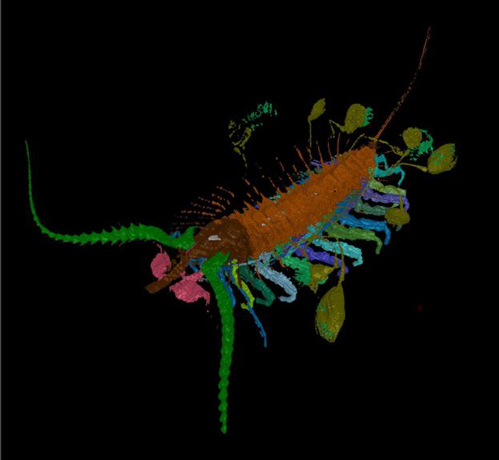The “Kite Runner” from the Silurian of England
Aquilonifer spinosus – Meet the “Kite Runner” from the Silurian
A team of international researchers including scientists from Leicester University, Oxford University, Imperial College London and Yale have published a paper on a two centimetre long, ancient Arthropod that once scuttled around an ancient Silurian sea floor. The fossil, preserved in almost three-dimensions has slowly emerged from its volcanic ash matrix and the specimen is not only a new species but it reveals a novel way of brooding its young.
The new species is named in honour of the best selling 2003 novel “The Kite Runner” by Khalid Hosseini, as the young are tethered to the adult’s body in capsules or pouches that reminded the research team of kites.
A Computer Generated Three-dimensional Image of A. spinosus
Picture credit: D Briggs/D Siveter/M Sutton/D Legg
A Remarkable Fossil Site
The fossil comes from a remarkable site in Herefordshire (England), close to the Welsh borders. The limestone strata is interrupted by a finely grained bedding plane that represents the ash from a volcanic eruption that settled on the seabed some 430 million years ago. This ash choked, buried and killed a lot of the Arthropods and other creatures that lived on or around the sea floor, and the Silurian Herefordshire Lagerstätte has provided palaeontologists with an unique opportunity to study microfossils in exquisite detail.
The genus name Aquilonifer comes from the Latin “aquila” for eagle or kite and the suffix “fer” which means to carry. The paper describing the study has been published in the academic journal “Proceedings of the National Academy of Sciences”.
Lead author, Professor Derek Briggs (Yale University and Royal Society Fellow), commented:
“Modern crustaceans employ a variety of strategies to protect their eggs and embryos from predators, attaching them to the limbs, holding them under the carapace or enclosing them within a special pouch until they are old enough to be released, but this example is unique.”
Strategy for Raising Young
No member of the Arthropoda, alive today (as far as we at Everything Dinosaur are aware), adopts such a strategy towards raising the next generation. As only one fossil specimen has been found and since no Arthropod known to science has evolved this behaviour, the fossil may record one reproduction strategy that ultimately proved to be unsuccessful, or at least less successful than other strategies employed by competing organisms.
Revealing the Tiny Fossil of Aquilonifer spinosus
The scientists were able to identify A. spinosus using a process whereby high intensity scanning photographs are taken, in a virtual slice by slice of the specimen. The results are then fed into a powerful computer programme that generates a three-dimensional image of the animal, including soft body parts such as, in this case, the pouches or capsules that held juveniles. The picture in this blog article is therefore an image of the “virtual fossil” that has been generated by this process.
The “Kite Runner” shows ten juveniles attached at various stages of development, all connected to the adult. The researchers suggest that the adult delayed its moult until the juveniles were old enough to hatch, otherwise, the juveniles would have been cast adrift as the exoskeleton was shed. It had been considered that the strange capsules/pouches with their tethers were some form of parasite, but the attachment seemed too uniform and the attachment position was not very favourable when it came to trying to access nutrients from the host.
Aquilonifer spinosus
Aquilonifer spinosus shared its marine environment with a host of other invertebrates including ostracods, brachiopods, worms, gastropods (snails), sea stars, and various shrimp-like creatures. The scientists suggest that this animal was a mandibulate, belonging to a clade of the Arthropoda that includes crustaceans, and modern insects. It lacked eyes and probably relied upon its long, robust antenna to find its way about, the trunk had eleven body segments which all had tiny jointed limbs to help it scuttle along the seabed.
Co-author, Dr. Legg of Oxford University stated that this bizarre creature that seems to have kept its babies close to it by thin threads may have had a segmented body and an exoskeleton but deciding where in the Order Arthropoda it fitted proved a tricky task.
Over the last few years, Everything Dinosaur has covered a number of fossil discoveries from the Silurian Herefordshire Lagerstätte made using the same techniques employed in this study.
To visit Everything Dinosaur’s website: Everything Dinosaur.
To read about the discovery of a strange ostracod fossil: Ancient Ostracod from Herefordshire
To read about a rather nasty surprise revealed by this fossil preparation process: Prehistoric Parasites from the Silurian


